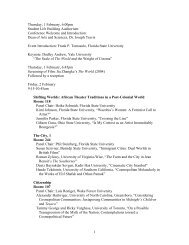Visibility now: Historicizing foreign presences in translation - English ...
Visibility now: Historicizing foreign presences in translation - English ...
Visibility now: Historicizing foreign presences in translation - English ...
Create successful ePaper yourself
Turn your PDF publications into a flip-book with our unique Google optimized e-Paper software.
Downloaded by [Florida State University], [Anne Coldiron] at 07:12 30 March 2012<br />
Translation Studies 195<br />
as well as ‘‘I never drank of Aganippe well’’ and others, cont<strong>in</strong>ue the visibly<br />
recusatory attitude toward prior poetry, which for some readers comes to look as<br />
dis<strong>in</strong>genuous as the persona’s other protestations. Regardless, these poems <strong>in</strong>sist on<br />
our attention to <strong>in</strong>tertextuality and to the imitation of <strong>foreign</strong> poetry. Recusatory<br />
sprezzatura actually makes the <strong>foreign</strong> <strong>presences</strong> showily visible.<br />
Watson’s thoroughly visible metatexts and Sidney’s deny-and-display may be<br />
endpo<strong>in</strong>ts on a spectrum of visible Renaissance lyric engagements with <strong>foreign</strong><br />
literature. But they are not unrepresentative: the work of Spenser, Shakespeare and<br />
any number of other early modern <strong>English</strong> poets, not to mention cont<strong>in</strong>ental poets<br />
after Triss<strong>in</strong>o <strong>in</strong> Italy and the Pléiade poets <strong>in</strong> France, followed similar methods.<br />
Most worked harder at the appearance of ease than Watson, while nevertheless<br />
keep<strong>in</strong>g their <strong>in</strong>terl<strong>in</strong>gual engagements visible to the Renaissance reader. Just as<br />
medieval translators’ visibility supported the value placed on auctoritas, visibility <strong>in</strong><br />
early modern literature supported the value placed on competitive imitatio (even<br />
when modulated by sprezzatura). Considered from a slightly different angle, the<br />
chang<strong>in</strong>g construction of the visibility of the translator reveals literary values<br />
gradually shift<strong>in</strong>g from what we have retrospectively come to periodize as ‘‘medieval’’<br />
<strong>in</strong>to what we <strong>now</strong> call ‘‘early modern’’ or ‘‘Renaissance’’ literature. In that great age<br />
of <strong>translation</strong>, the translator’s presence and the presence of the <strong>foreign</strong> cont<strong>in</strong>ue to<br />
show, less as marks of authority than as marks of artistic agency, but, as ever, <strong>in</strong><br />
concert with broader aesthetic and cultural agendas.<br />
Beyond Babel: Future potentials for visibility <strong>in</strong> <strong>translation</strong>?<br />
My first qualification to the historical sketch above is that it ignores non-Western<br />
<strong>translation</strong> histories, which certa<strong>in</strong>ly have their own ways of constru<strong>in</strong>g and valu<strong>in</strong>g<br />
the translator’s <strong>in</strong>/visibility. The second problem with this k<strong>in</strong>d of brief overview<br />
is that it risks re<strong>in</strong>forc<strong>in</strong>g the very fallacies of periodization that we k<strong>now</strong> <strong>translation</strong><br />
challenges so effectively (Coldiron 2009). Yet to stretch Venuti’s concept back to<br />
periods prior to those for which it was designed shows how usefully elastic it is;<br />
visibility <strong>in</strong> <strong>translation</strong> served identifiable values <strong>in</strong> the history of European literary<br />
systems prior even to the problematic he poses. S<strong>in</strong>ce visibility and <strong>in</strong>visibility have<br />
meant such different th<strong>in</strong>gs <strong>in</strong> different times and places, they are an important <strong>in</strong>dex<br />
to ideological and aesthetic change. Just as <strong>in</strong>visibility has been a key concept for<br />
<strong>translation</strong> studies, perhaps visibility, considered historically, can become a<br />
methodological key to broader cultural and aesthetic agendas <strong>in</strong> contemporary<br />
and future <strong>translation</strong> studies.<br />
Aga<strong>in</strong>st visibility <strong>in</strong> <strong>translation</strong>, of course, there have been some powerful ideas.<br />
First, <strong>in</strong>visibility has susta<strong>in</strong>ed specific literary-aesthetic values s<strong>in</strong>ce the eighteenth<br />
century, as Venuti and others follow<strong>in</strong>g him have confirmed. As long as a chief<br />
benchmark of literary value rema<strong>in</strong>s the unique genius of <strong>in</strong>dividual authors work<strong>in</strong>g<br />
alone, translators and their work must rema<strong>in</strong> <strong>in</strong>visible, as Venuti shows. To the<br />
degree that literary modernity rema<strong>in</strong>s committed to Romantic conceptions of<br />
orig<strong>in</strong>ality and to s<strong>in</strong>gle-author confessional modes, <strong>in</strong>visibility will rule. Neither the<br />
visibility of the translator (who disrupts the fiction of orig<strong>in</strong>al authorship), nor the<br />
visibility of the <strong>foreign</strong> (which disrupts fictions of purity and national literary<br />
identity), can hold much aesthetic sway. In national literary canons and curricula,<br />
which are after all based on national literary identities, marks of the <strong>foreign</strong> will have




